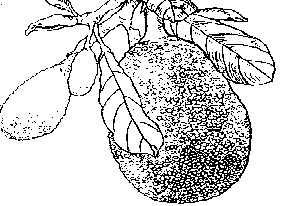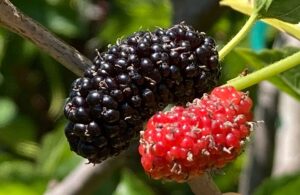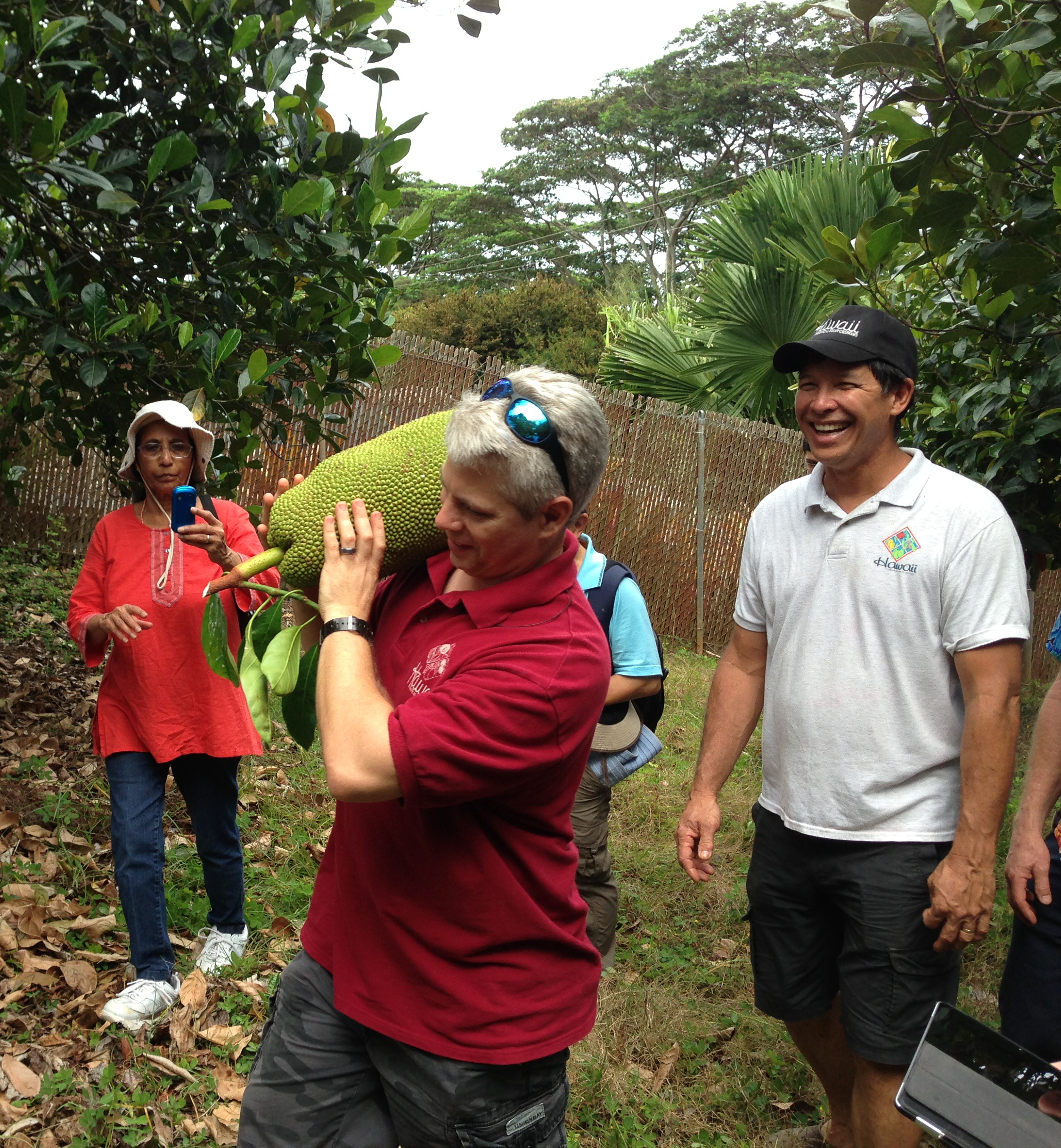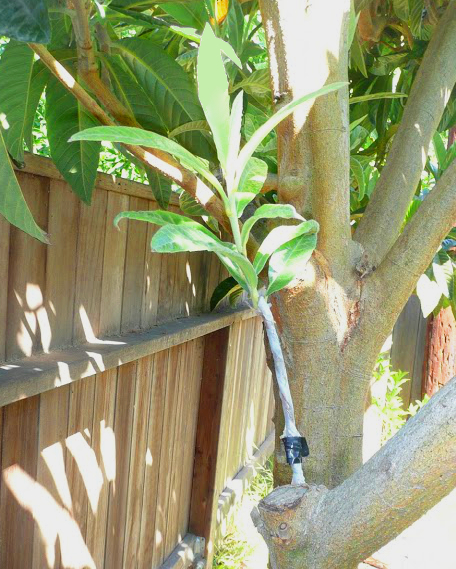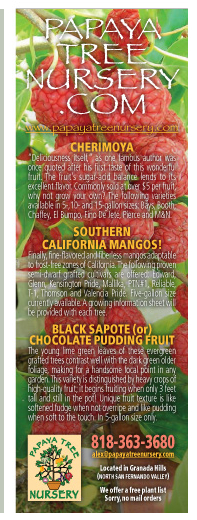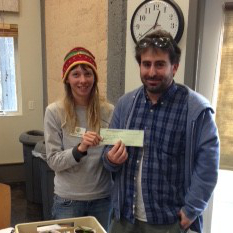FIG

Ficus carica L.
Moraceae
Common Names: Fig (English), Higo (Spanish), Figue (French), Feige (German), Fico (Italian).
Related Species: Cluster fig (Ficus racemosa), Sycomore Fig (Ficus sycomorus).
Distant Affinity: Mulberry (Morus spp.); Breadfruit (Artocarpus altilis Fosb.); Jakfruit (Artocarpus heterophyllus Lam.); Che; Chinese Mulberry (Cudrania tricuspidata).
Origin: The fig is believed to be indigenous to western Asia and to have been distributed by man throughout the Mediterranean area. Remnants of figs have been found in excavations of sites traced to at least 5,000 B.C.
Adaptation: The fig grows best and produces the best quality fruit in Mediterranean and dryer warm-temperate climates. Rains during fruit development and ripening can cause the fruits to split. With extra care figs will also grow in wetter, cooler areas. Diseases limit utility in tropical climates. Fully dormant trees are hardy to 12° – 15° F, but plants in active growth can be damaged at 30° F. Fig plants killed to the ground will often resprout from the roots. Only the hardiest cultivars should be attempted in areas such as the Willamette Valley, the Sierra Nevada and high desert. However, all cultivars are suitable elsewhere in California. Chilling requirements for the fig are less than 300 hours. In containers figs are eye-catching specimens inside or outdoors. It is best to choose a slow-growing cultivar.
DESCRIPTION
Growth Habit: The fig is a picturesque deciduous tree, to 50 ft tall, but more typically to a height of 10 – 30 ft. Their branches are muscular and twisting, spreading wider than they are tall. Fig wood is weak and decays rapidly. The trunk often bears large nodal tumors, where branches have been shed or removed. The twigs are terete and pithy rather than woody. The sap contains copious milky latex that is irritating to human skin. Fig trees often grow as a multiple-branched shrub, especially where subjected to frequent frost damage. They may be espaliered, but only where roots may be restricted, as in containers.
Foliage: Fig leaves are bright green, single, alternate and large (to 1 ft length). They are more or less deeply lobed with 1 – 5 sinuses, rough hairy on the upper surface and soft hairy on the underside. In summer their foliage lends a beautiful tropical feeling.
Flowers: The tiny flowers of the fig are out of sight, clustered inside the green “fruits”, technically a synconium. Pollinating insects gain access to the flowers through an opening at the apex of the synconium. In the case of the common fig the flowers are all female and need no pollination. There are 3 other types, the caprifig which has male and female flowers requiring visits by a tiny wasp, Blastophaga grossorum; the Smyrna fig, needing cross-pollination by caprifigs in order to develop normally; and the San Pedro fig which is intermediate, its first crop independent like the common fig, its second crop dependent on pollination.
Fruits: The common fig bears a first crop, called the breba crop, in the spring on last season’s growth. The second crop is borne in the fall on the new growth and is known as the main crop. In cold climates the breba crop is often destroyed by spring frosts. The matured “fruit” has a tough peel (pure green, green suffused with brown, brown or purple), often cracking upon ripeness, and exposing the pulp beneath. The interior is a white inner rind containing a seed mass bound with jelly-like flesh. The edible seeds are numerous and generally hollow, unless pollinated. Pollinated seeds provide the characteristic nutty taste of dried figs.
CULTURE
Location: Figs require full sun all day to ripen palatable fruits. Trees become enormous, and will shade out anything growing beneath. Repeated pruning to control size causes loss of crop. The succulent trunk and branches are unusually sensitive to heat and sun damage, and should be whitewashed if particularly exposed. Roots are greedy, traveling far beyond the tree canopy. Figs are not a fruit tree for small places. The fine roots that invade garden beds, however, may be cut without loss to the tree. In areas with short (less than 120 days between frosts), cool summers, espalier trees against a south-facing, light-colored wall to take advantage of the reflected heat. In coastal climates, grow in the warmest location, against a sunny wall or in a heat trap. For container grown plants, replace most of the soil in the tub every three years and keep the sides of the tub shaded to prevent overheating in sunlight.
Irrigation: Young fig tees should be watered regularly until fully established. In dry western climates, water mature trees deeply at least every one or two weeks. Desert gardeners may have to water more frequently. Mulch the soil around the trees to conserve moisture. If a tree is not getting enough water, the leaves will turn yellow and drop. Also, drought-stressed trees will not produce fruit and are more susceptible to nematode damage. Recently planted trees are particularly susceptible to water deficits, often runt out, and die.
Pruning: Fig trees are productive with or without heavy pruning. It is essential only during the initial years. Trees should be trained according to use of fruit, such as a low crown for fresh-market figs. Since the crop is borne on terminals of previous year’s wood, once the tree form is established, avoid heavy winter pruning, which causes loss of the following year’s crop. It is better to prune immediately after the main crop is harvested, or with late-ripening cultivars, summer prune half the branches and prune the remainder the following summer. If radical pruning is done, whitewash the entire tree.
Fertilization: Regular fertilizing of figs is usually necessary only for potted trees or when they are grown on sands. Excess nitrogen encourages rank growth at the expense of fruit production, and the fruit that is produced often ripens improperly, if at all. As a general rule, fertilize fig trees if the branches grew less than a foot the previous year. Apply a total of 1/2 – 1 pound of actual nitrogen, divided into three or four applications beginning in late winter or early spring and ending in July.
Frost Protection: In borderline climates, figs can be grown out of doors if they are given frost protection. Brown Turkey, Brunswick and Blue Celeste cultivars are some of the best choices. Plant against a wall or structure which provides some heat by radiation. Or grow as a bush, pruning the trunk to near ground level at the end of the second year. Allow several stems to replace the trunk, and grow as you would a lilac. For further protection, erect a frame over the plant, covering and surrounding it with heavy carpet in winter. Keep the roots as dry as possible during winter, raising a berm to exclude melting snows during thaws. In northern climates, the fig is best grown as a tub or pot plant that can be brought into a warm location in winter and taken out again in spring. Dormant buds are more susceptible to freezing than wood. Freezing may also create a trunk without live buds; regrowth is possible only from roots.
Propagation: Fig plants are usual propagated by cuttings. Select foot-long pieces of dormant wood, less than 1 inch diameter, with two-year-old wood at base. One-year twigs with a heel of two-year branch at the base may also be used. Dip the cuttings in a rooting hormone and allow them to callus one week in a moist place at 50-60° F. Summer cuttings may also be made, but they do best if defoliated and winterized in a refrigeration for 2-3 weeks before potting. Leafy shoots require a mist bed. Particularly rare cultivars may be propagated on rootstocks, or older trees, topworked by whip, cleft or crown grafting, or chip or patch budding. Rooted cuttings should be planted in 22 to 30 feet squares, depending upon the capacity of the soil and the ultimate size of the tree. Keep roots moist until planted. Never transplant or disturb a young tree while it is starting new growth in spring, as this is likely to to kill it. Cut the tree back to 2 ft high upon planting and whitewash the trunk.
Pests and Diseases: Fig tree roots are a favorite food of gophers, who can easily kill a large plant. One passive method of control is to plant the tree in a large aviary wire basket. Deer are not particularly attracted to figs, but birds can cause a lot of damage to the fruit. Nematodes, particularly in sandy soils, attack roots, forming galls and stunting the trees. Mitadulid and Carpophilus dried fruit beetles can enter ripening fruit through the eye and cause damage by introducing fungi and rots. They frequently breed in fallen citrus fruits. Keep a clean orchard by destroy fallen fruits and do not grow near citrus trees. Euryphid mites cause little damage but are carriers of mosaic virus from infected to clean trees.
Mosaic virus, formerly considered benign, probably causes crop reduction. Symptoms resemble potassium deficiency–leaves are marbled with yellow spots, and the veins are light colored. Symptoms are often not apparent until the tree is older or when it becomes heat or water-stressed. Do not purchase infected trees and isolate those which show symptoms. Botrytis causes a blast of branch terminals, which dry out and turn charcoal-like. The attack usually starts from half-grown fruits damaged by the first frost of winter, then enters the main stem as a reddish expanding necrotic zone. The infection is generally self-controlling and stops in the spring. It can be prevented by removing mummies and frost damaged fruits as soon as they are observed. Fig canker is a bacterium which enters the trunk at damaged zones, causing necrosis and girdling and loss of branches. It usually starts at sunburned areas, so it is important to keep exposed branches whitewashed. Rhyzopus smut attacks ripened fruits on the tree, causing charcoal black coating inside the fruit, and is worst on cultivars with large, open eyes. Most ripe fruit losses are from Endosepsis (Fusarium) and Aspergillus rot which is introduced by insects, even pollinating wasps. The fruit appears to burst, or a ropy, mucus-like exudate drains from the eye, rendering the fruit are inedible. The best control is to destroy all crop for one year, apply diazinon granules beneath trees to eliminate insect vectors, and destroy adjacent wild trees. Penicillium fungus will attack dried fruits in storage but can be controlled by keeping them dry, or sulfuring before storage.
Harvest: Figs must be allowed to ripen fully on the tree before they are picked. They will not ripen if picked when immature. A ripe fruit will be slightly soft and starting to bend at the neck. Harvest the fruit gently to avoid bruising. Fresh figs do not keep well and can be stored in the refrigerator for only 2 – 3 days. Some fig varieties are delicious when dried. They take 4 – 5 days to dry in the sun and 10 -12 hours in a dehydrator. Dried figs can be stored for six to eight months.
Commercial potential: Because of losses in transport and short shelf life, figs are a high-value fruits of limited demand. The best outlet is direct sale at roadside or farmers markets, but do not permit handling of the fruit. Figs for shipping are collected daily just before they reach the fully ripe stage, but yield to a soft pressure, usually indicated by small cracks in the skin. They should be immediately refrigerated. For commerce, choose a cultivar that parts readily from the branch and does not tear the neck.
CULTIVARS
- Adriatic (Fragola, Strawberry Fig, Verdone, White Adriatic)
- Origin central Italy, Small to medium, skin greenish, flesh strawberry colored. Good, all-purpose fig. Light breba crop. Large vigorous tree leafs out early; subject to frost damage. Prune to force new growth.
- Black Mission (Beers Black, Franciscan, Mission)
- Origin Balearic Islands. Fruits all-over black purple, elongated, Flesh watermelon to pink, fairly good taste. Easily dried at home. Single best all-round variety for south, north, coast, interior. Brebas prolific, fairly rich. Tree very large, plant at maximum spacing. Do not prune after tree reaches maturity. Commences growth midseason.
- Blanche (Italian Honey fig, Lattarula, Lemon, White Marseille)
- Medium to large, skin yellowish green, flesh white to amber, very sweet, lemon flavor. Light breba crop. Valuable in short-season, cool-summer areas. Slow growing, dense, hardy tree.
- Brown Turkey (Aubique Noire, Negro Largo, San Piero
- Origin Provence. Medium, skin is purplish brown, flesh pinkish amber. Good flavor. Best when fresh. Light breba crop. Small, hardy, vigorous tree. Prune severely for heaviest main crop. Does best in southern California.
- Celeste (Blue Celeste, Honey Fig, Malta, Sugar, Violette)
- Small to medium, skin is light violet to violet-brown, flesh reddish amber. Very sweet, usually dried. Light breba crop. Tightly closed eye, good for Southeast. Small, productive, hardy.
- Conadria
- Origin Ira Condit, Riverside 1956. First artificial hybrid fig. Fruit pale green, medium, flesh strawberry red. Mildly sweet. Good fresh, excellent dried. More productive than Adriatic but of lesser quality. Light breba crop. Tree vigorous, tends to excessive growth under irrigation, best in hot climates.
- Croisic (Cordelia, Gillette, St. John)
- Only edible caprifig. Fruits very early, only brebas are useful. Fruits pale yellow, small, pulp nearly white, without a lot of character. Tree low, dense, spreading. . For north coast and Pacific Northwest.
- Desert King (Charlie, King)
- Origin Madera, Calif. 1920. San Pedro type. Large, skin is deep green, minutely spotted white, pulp strawberry red. Sweet, delicious fresh or dried. Commonly matures good fruit without caprification near the coast. Tree highly vigorous. Hardy, best adapted to to cool areas such as the Pacific Northwest.
- Excel
- Origin W.B. Storey, Riverside, 1975. Large, skin is yellow, flesh light amber. Fruits practically neckless, blocky. Very sweet. Excellent, all-purpose fig. Light breba crop. Similar to Kadota but more productive. Tree vigorous, even rank. Does well in most parts of California.
- Flanders
- Origin I.J. Condit, Riverside, 1965. Seedling of White Adriatic. Medium, long neck, skin is brownish yellow with violet stripes, flesh amber. Strong, fine flavor. Excellent all-purpose fruit. Good breba crop. Ripens late. Tree vigorous but requires no great pruning. For south coastal California, San Joaquin Valley.
- Judy
- Origin Leonard Jessen, Pasadena, 1986. Probable seedling of California Brown Turkey. Large and broad, fruit is brown to black, pulp pink.
- Kadota (Dottato, Florentine, White Kadota)
- Medium, skin is yellowish green, flesh amber, tinged pink at center. Flavor rich. Resists souring. Little or no breba crop. Tree upright, requires annual pruning to slow growth. Requires hot, dry climate for best quality.
- Len
- Origin Leonard Jessen, Pasadena, 1984. Seedling of Black Mission. Fruit smaller than Mission, black, pulp pink, quite sweet.
- Osborn’s Prolific (Arachipel, Neveralla)
- Medium to large, skin is dark reddish brown, flesh amber, often tinged pink. Very sweet, best fresh. Light breba crop. Tree upright, bare, will grow in shade. Ripens late. Only for north coast, Pacific Northwest. Poor in warm climates.
- Panachee (Striped Tiger, Tiger)
- Small to medium, skin is greenish yellow with dark green strips, flesh strawberry, dry but sweet. Best fresh. No breba crop. Requires long, warm growing season. Ripens late.
- Tena
- Origin W.B. Storey, Riverside, 1975. Small, skin is light green,flesh amber. Fine flavor. Good fresh or dried. Good breba crop. Bears heavily. Tree strong, dense. For coastal California and interior south.
- Genoa (White Genoa)
- Medium, skin is greenish yellow to white, flesh yellow-amber. Sweet, good fresh or dried. Light breba and main crops.Tree upright, requires constant annual pruning. Best adapted to cooler regions of the West. Very late in northern California, continuing to ripen even after first frosts.
- Ventura
- Large, skin is green, flesh deep red, long neck. Excellent flavor. Good fresh or dried. Good breba crop. Ripens late but matures well in cool areas. Compact tree.
- Verte (Green Ischia)
- Small, skin is greenish yellow, flesh strawberry. Excellent fresh or dried. Good breba crop. Small tree. Recommended for short-summer climates.
FURTHER READING
- Condit. I. J. The Fig. Waltham, Mass., Chronica Botanica Co., 1947.
- Condit, I. J. Fig Culture in California. Extension Service Circular 77, 1933.
- Condit, I. J. Fig Varieties: A Monograph. Hilgardia 23:11 (Feb 1955).
- Eisen, G. The Fig – Its History, Culture and Curing. U.S. Department of Agriculture Bulletin 9 . 1901.
- Eisen, G. and F. S. Earle. Fig Culture. U.S. Department of Agriculture Bulletin 5, 1897.
- Morton, Julia F. Fruits of Warm Climates. Creative Resources Systems, Inc. 1987. pp. 47-50.
- Ortho Books. All About Citrus and Subtropical Fruits. Chevron Chemical Co. 1985. pp. 46-48.
- Schurrie, H. The Fig. Timber Press Horticultural Reviews 12:409 (1990)
- Starnes, H. N. The Fig in Georgia. Georgia Experiment Station Bulletin 61, 1903.
- Starnes, H. N. and J. F, Monroe. The Fig in Georgia. (2nd Report). Georgia Experiment Station Bulletin 77.
See Index of CRFG Publications, 1969 – 1989 and annual indexes of Fruit Gardener for additional articles on the fig.
Here is the list of additional CRFG Fruit Facts.
© Copyright 1996, California Rare Fruit Growers, Inc.
Questions or comments? Contact us.
